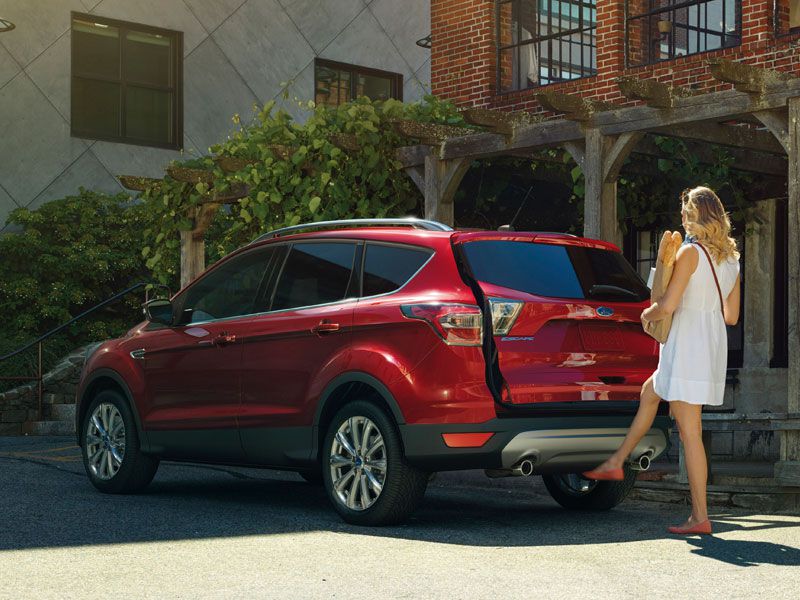Recent Articles
Popular Makes
Body Types
2017 Ford Escape Road Test and Review with Video
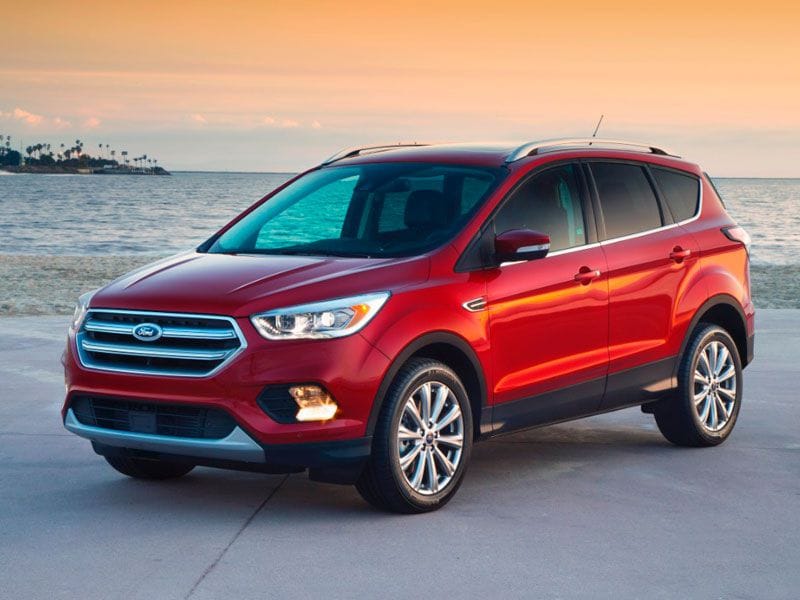
2017 Ford Escape ・ Photo by Ford
Ford is turning up the wick on its highly popular Escape SUV in 2017, with a refresh that slips a host of important technologies into a crisply updated design. As a result, the 2017 Escape now goes toe to toe with the best in the class on safety and driver-assistance tech. Three levels of trim continue—S, SE, and Platinum—and an updated trio of engines provides choices that rivals will scramble to match.
In 2015, Ford sold 306,492 Escapes, making the small crossover the second best-selling vehicle in the Ford lineup, after the F-150 pickup. It's poised to go higher this year, with the redesigned 2017 model.
At New York City's old Post Office Building, Ford introduced the 2017 Escape to the automotive press. Autobytel attended this "Escape New York City" event to learn more about this important and popular Ford.
2017 Ford Escape: The Competition
The small crossover/SUV segment is red hot, and the Ford Escape is in the thick of it, with a big tick up in May sales due to the new model. The Escape was the third-best-selling small crossover in America in 2015, following the Honda CR-V and Toyota RAV4, which were both updated for the 2016 model year. Notable competitors include the Nissan Rogue, Chevrolet Equinox, Jeep Cherokee, and Mazda CX-5 along with the Hyundai Tucson and Kia Sportage, which have also seen recent updates. Like the Escape, the Tucson and Sportage offer turbocharged direct-injected engines. While they’re only a fraction as popular as the market leaders, both the Tucson and Sportage are enjoying a whopping jump in sales in 2016.
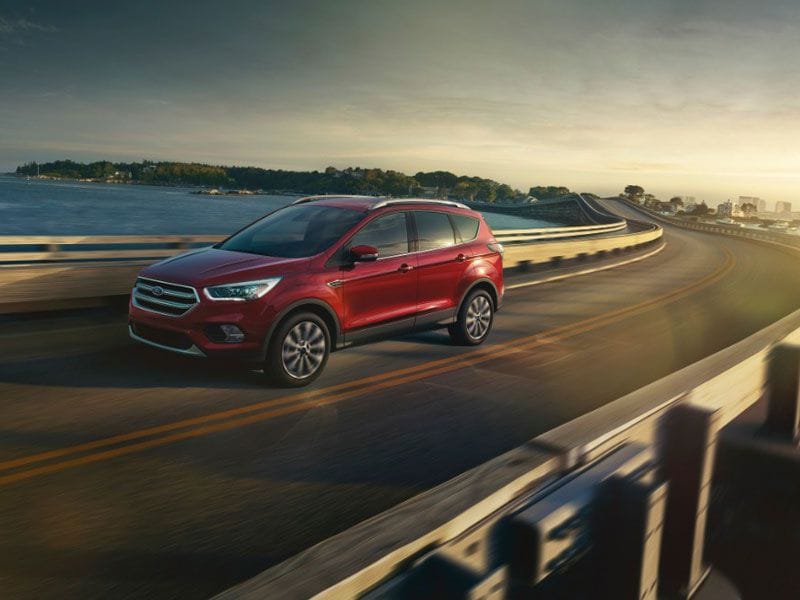
Photo by Ford
2017 Ford Escape: Exterior Changes
The 2017 Escape’s exterior refresh implements significant changes to the nose and tail. The Escape’s face has changed dramatically, with hood accent lines that have moved outward and alleviated the pinched look of the outgoing model. Upper and lower front grilles have swapped prominence, with the 2017 gaining a bold upper trapezoidal grille that shines with bright chrome horizontal elements and surrounding trim. A metallic-finish splitter sets off the lower grille. It’s a far more premium look overall, with LED daytime running lamps standard on the Escape Platinum. New exterior colors include Lightning Blue (replacing Deep Impact Blue), Canyon Ridge (replacing Sunset), and White Gold (replacing Electric Spice). A new Sport Appearance Package features 19-inch Ebony Black wheels and a host of blacked-out trim.
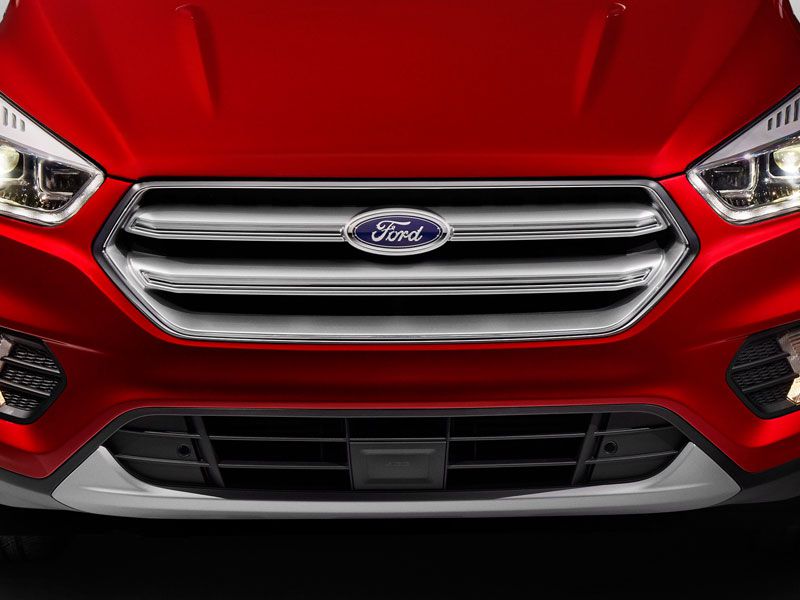
Photo by Ford
2017 Ford Escape: Interior Updates
Significant updates have been made to the Escape’s interior, with a great deal of attention paid to the center console’s ergonomics. The old-school handbrake is gone, replaced with an electronic pushbutton unit. A storage bin at the front of the console houses a lighted USB port and 12-volt power outlet, and storage has been added around the shifter. Cupholder aficionados will rejoice in the center console’s “improved cupholders designed to accommodate cups of all sizes” (let's pin that on the Big Gulp). The Escape may seat five, but there are a total of eight cupholders inside. If you get dehydrated on a long drive, you have no one to blame but yourself. The leather-wrapped steering wheel’s been revamped to house a bevy of buttons. A heated steering wheel and front bucket seats are standard on the Titanium model, along with 10-way power adjustment and power lumbar support, and driver seat memory. The optional Panoramic Vista sunroof ($1495) gives the cabin an open, airy feel. The second row seats are quite accommodating, with a center armrest, 39 inches of head room and 37.3 inches of legroom. The recline angle is most appreciated.
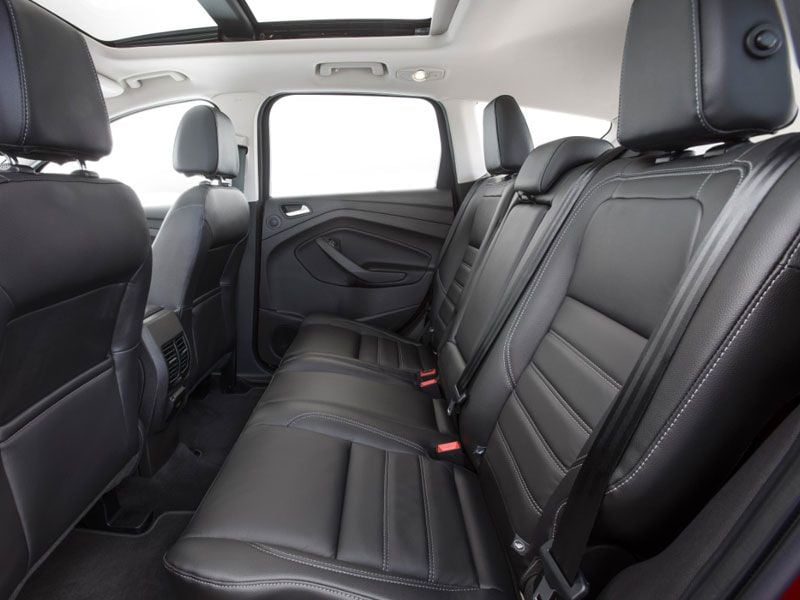
2017 Ford Escape: Infotainment Updates
The 2017 Escape’s infotainment system has taken a huge step up with Ford Sync 3, along with support for Apple CarPlay and Android Auto. While the first two versions of Sync were based on Microsoft’s pokey technology, Sync 3 switches to Blackberry’s operating system and it’s a whole lot snappier. Support for apps is built into Sync3, which should theoretically provide more options than CarPlay (Apple is notoriously tight about approving apps). Spotify, Glympse, and iHeartRadio are currently supported. A 10-speaker Sony audio system delivers the tunes in the Escape Titanium. There are four power outlets in all, with three on the center console (front, rear, inside) and one in the cargo area. The rear center console provides a 110V outlet. The new Ford Pass Sync Connect app allows Escape owners to lock, unlock, locate, and start their vehicles remotely from an iPhone or Android device. You can even check the fuel level.
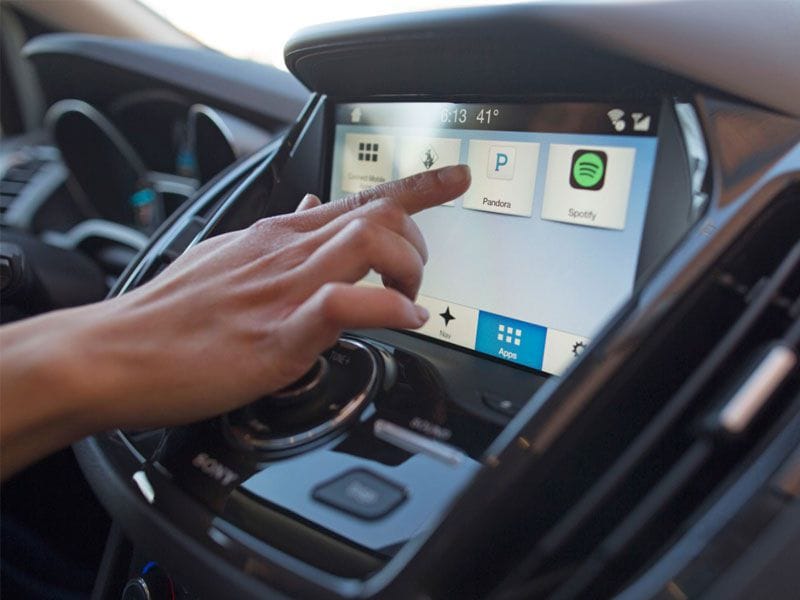
2017 Ford Escape: Safety Technology
A comprehensive array of safety and convenience technology is offered on the 2017 Escape Titanium. Standard features include blindspot mirrors, rearview camera, and cross-traffic alert. The 301A option package ($1995) dials it up with features that include Automatic High Beams, Bi-Xenon HID headlamps, and a Driver Alert system. Highway travel is eased by Lane-Keep Alert, which warns of lane departure, and Lane-Keeping Aid, which gently steers the Escape back into its lane.
The magic continues with the Escape’s Enhanced Active Park Assist system, which eases parking chores. It's largely a hands-off affair. The driver follows prompts to shift gears, apply throttle, and brakes, as the system automatically steers the Escape into parallel or perpendicular parking spots.
Adaptive Cruise Control (ACC) automatically maintains a safe following distance on the highway and is a desirable standalone option at $595. If you've never driven a car with ACC, you'll definitely want to check this out on your test drive.
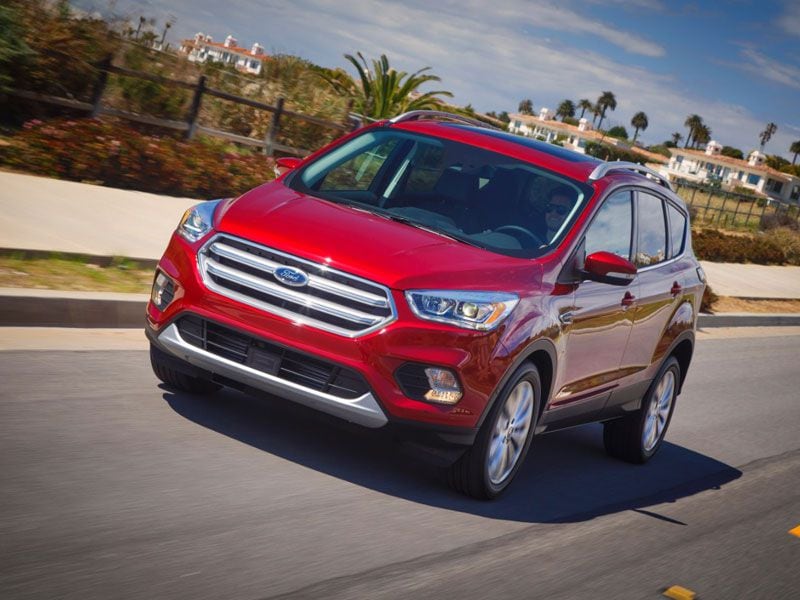
Photo by Ford
2017 Ford Escape: Engine Choices
The 2017 Ford Escape offers three engine choices: a naturally aspirated 2.5-liter four, a 1.5-liter EcoBoost four, and a zippy 2.0-liter twin-scroll turbocharged EcoBoost four. You must have an EcoBoost engine to get all-wheel drive (AWD). The base 2.5-liter produces 168 horsepower, with EPA fuel economy of 21 mpg city/28 mpg highway. The 1.5-liter EcoBoost bumps it up to 179 horsepower, with fuel economy of 23 mpg city/30 mpg highway with front-wheel drive (FWD). The 2.0-liter twin-scroll EcoBoost cranks out 245 horsepower, while returning 22 mpg city/ 29 mpg highway with FWD. It's a $1295 option on either the SE or Titanium. All three engines can operate on 87-octane gasoline, but 91+ octane is recommended for the 2.0-liter EcoBoost. Octane significantly effects fuel economy and performance. Ford's 2017 Escape is exclusively fitted with 6-speed automatic transmission. Both EcoBoost engines are equipped with Auto Start/Stop systems to shut the engine down while idling (to conserve fuel), as well as paddle shifters.
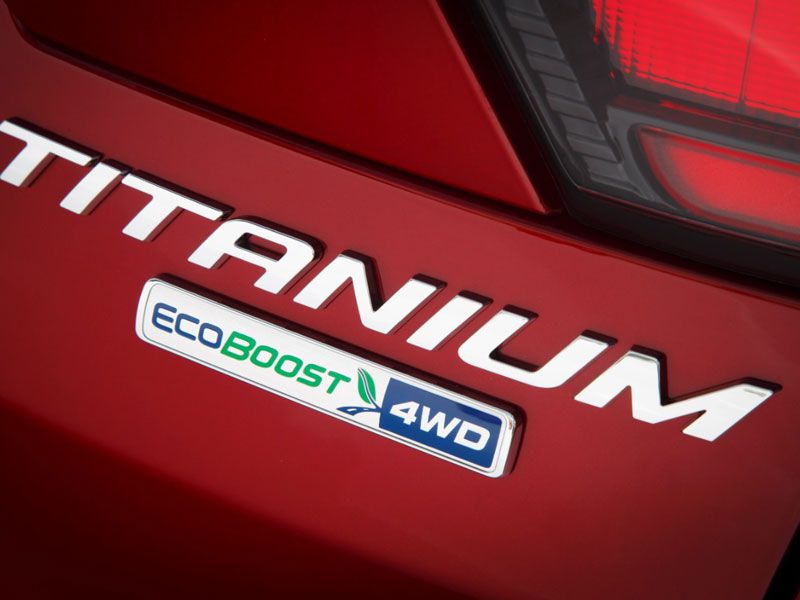
2017 Ford Escape: Engines, Part 2
Our test Escape was equipped with the 1.5-liter EcoBoost engine. The mid-level 1.5L fell a bit short on its fuel economy ratings in a week's worth of driving in mixed summer conditions, delivering 24.1 mpg, but that's to be expected with constant use of the air conditioning and lots of in-town traffic. Although power delivery was adequate with the 1.5L, the 2.0L EcoBoost engine offers a considerable bump in performance without a significant drop in gas mileage.
Both the 1.5L and 2.0L EcoBoost engines are new in the Escape for 2017. The 1.5L replaces the 1.6L EcoBoost and the 2.0L twin-scroll updates the previous 2.0L. While Ford’s trio of engine choices is most welcome, Toyota delivers the highest fuel economy in the class with the RAV4 Hybrid, which is rated at 34 mpg city/31 mpg highway. There’s still no word on when (or if) Ford will offer a hybrid version of the Escape. Is the FWD C-Max filling the need, or is there unmet demand for an AWD hybrid?
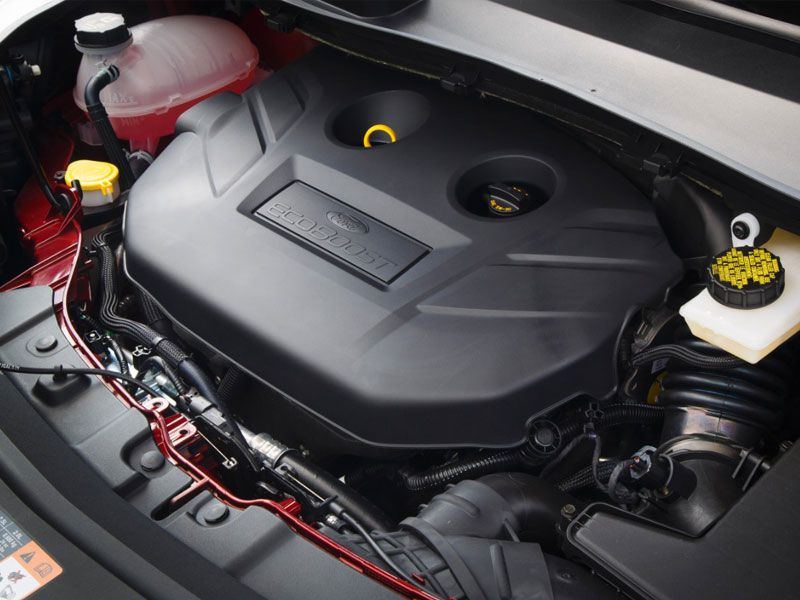
Photo by Ford
2017 Ford Escape: Cargo A Go Go
The Escape’s a happy little hauler, but there’s a bit less cargo space than in the competition. Loading chores are eased with the hands-free foot-activated lift gate (standard on the Titanium). Just swing your foot under the bumper and the lift gate magically opens. There’s 34 cubic feet of cargo capacity behind the second row seats, with 68 cubic feet available when the 60/40 seats are folded down. This falls short of the RAV4 with 38.4 and 73.4, respectively, as well as the CR-V with 37.2 and 70.9. But the Ford compares favorably with the Chevrolet Equinox, at 31.5 and 63.7 cubic feet. A 12-volt power outlet is found on the passenger side of the cargo area, and the spare tire is mounted beneath the floor.
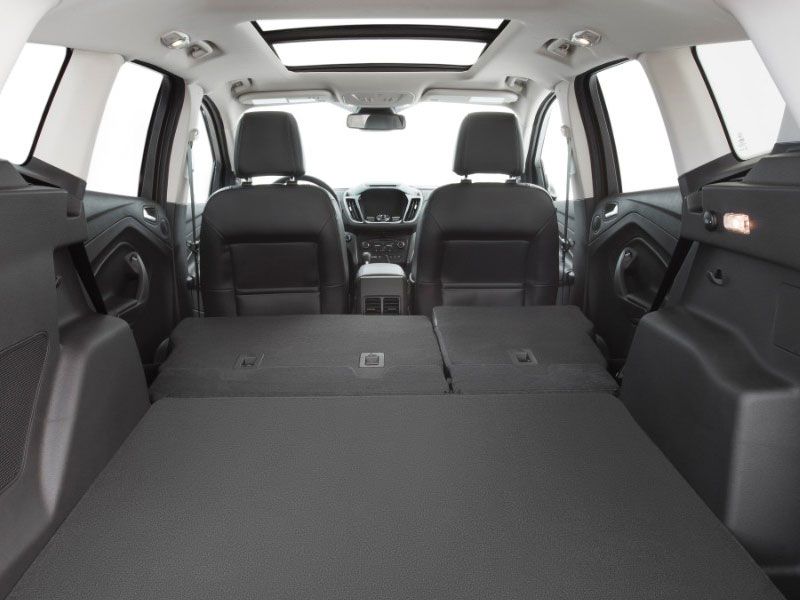
Photo by Ford
2017 Ford Escape: Bringing it Home
The compact crossover suv class is packed with contenders, and we are blessed with many solid choices. If you need more off-road capability, look to the Jeep Cherokee Trailhawk. If sporty handling is your thing, the Mazda CX-5 gets the nod. If you value fuel efficiency, scope out the Toyota RAV4 Hybrid. With so many great choices there's really no need to comprimise. Ford's new 2017 Escape rides well and handles with confidence. It offers multiple safety, technology, and drivetrain options, along with a crisp new design and engine choices that set it apart from the pack. Here's how we feel about the Escape: It's the one crossover SUV you must test against whatever model it is that's at the top of your list right now.
